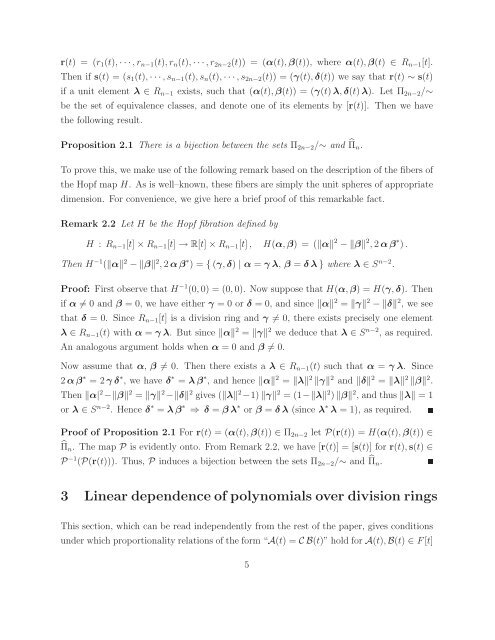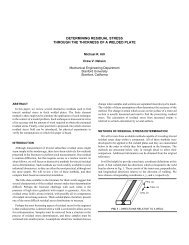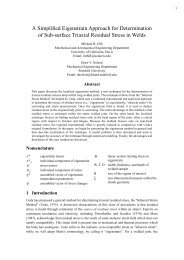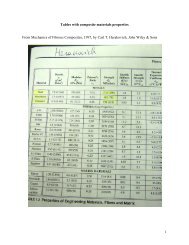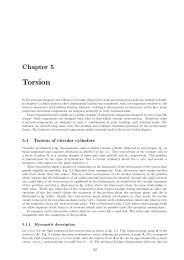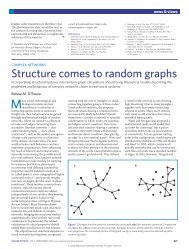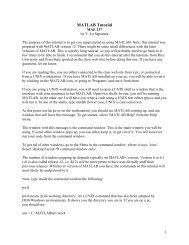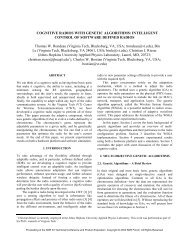Pythagorean-hodograph curves in Euclidean spaces of dimension ...
Pythagorean-hodograph curves in Euclidean spaces of dimension ...
Pythagorean-hodograph curves in Euclidean spaces of dimension ...
Create successful ePaper yourself
Turn your PDF publications into a flip-book with our unique Google optimized e-Paper software.
(t) = (r1(t), · · ·, rn−1(t), rn(t), · · ·, r2n−2(t)) = (α(t), β(t)), where α(t), β(t) ∈ Rn−1[t].<br />
Then if s(t) = (s1(t), · · ·, sn−1(t), sn(t), · · ·, s2n−2(t)) = (γ(t), δ(t)) we say that r(t) ∼ s(t)<br />
if a unit element λ ∈ Rn−1 exists, such that (α(t), β(t)) = (γ(t) λ, δ(t) λ). Let Π2n−2/∼<br />
be the set <strong>of</strong> equivalence classes, and denote one <strong>of</strong> its elements by [r(t)]. Then we have<br />
the follow<strong>in</strong>g result.<br />
Proposition 2.1 There is a bijection between the sets Π2n−2/∼ and Πn.<br />
To prove this, we make use <strong>of</strong> the follow<strong>in</strong>g remark based on the description <strong>of</strong> the fibers <strong>of</strong><br />
the Hopf map H. As is well–known, these fibers are simply the unit spheres <strong>of</strong> appropriate<br />
<strong>dimension</strong>. For convenience, we give here a brief pro<strong>of</strong> <strong>of</strong> this remarkable fact.<br />
Remark 2.2 Let H be the Hopf fibration def<strong>in</strong>ed by<br />
H : Rn−1[t] × Rn−1[t] → R[t] × Rn−1[t] , H(α, β) = (α 2 − β 2 , 2 αβ ∗ ) .<br />
Then H −1 (α 2 − β 2 , 2 αβ ∗ ) = { (γ, δ) | α = γ λ, β = δ λ } where λ ∈ S n−2 .<br />
Pro<strong>of</strong>: First observe that H −1 (0, 0) = (0, 0). Now suppose that H(α, β) = H(γ, δ). Then<br />
if α = 0 and β = 0, we have either γ = 0 or δ = 0, and s<strong>in</strong>ce α 2 = γ 2 − δ 2 , we see<br />
that δ = 0. S<strong>in</strong>ce Rn−1[t] is a division r<strong>in</strong>g and γ = 0, there exists precisely one element<br />
λ ∈ Rn−1(t) with α = γ λ. But s<strong>in</strong>ce α 2 = γ 2 we deduce that λ ∈ S n−2 , as required.<br />
An analogous argument holds when α = 0 and β = 0.<br />
Now assume that α, β = 0. Then there exists a λ ∈ Rn−1(t) such that α = γ λ. S<strong>in</strong>ce<br />
2 αβ ∗ = 2 γ δ ∗ , we have δ ∗ = λ β ∗ , and hence α 2 = λ 2 γ 2 and δ 2 = λ 2 β 2 .<br />
Then α| 2 −β 2 = γ 2 −δ 2 gives (λ 2 −1) γ 2 = (1−λ 2 ) β 2 , and thus λ = 1<br />
or λ ∈ S n−2 . Hence δ ∗ = λ β ∗ ⇒ δ = β λ ∗ or β = δ λ (s<strong>in</strong>ce λ ∗ λ = 1), as required.<br />
Pro<strong>of</strong> <strong>of</strong> Proposition 2.1 For r(t) = (α(t), β(t)) ∈ Π2n−2 let P(r(t)) = H(α(t), β(t)) ∈<br />
Πn. The map P is evidently onto. From Remark 2.2, we have [r(t)] = [s(t)] for r(t),s(t) ∈<br />
P −1 (P(r(t))). Thus, P <strong>in</strong>duces a bijection between the sets Π2n−2/∼ and Πn.<br />
3 L<strong>in</strong>ear dependence <strong>of</strong> polynomials over division r<strong>in</strong>gs<br />
This section, which can be read <strong>in</strong>dependently from the rest <strong>of</strong> the paper, gives conditions<br />
under which proportionality relations <strong>of</strong> the form “A(t) = C B(t)” hold for A(t), B(t) ∈ F[t]<br />
5


